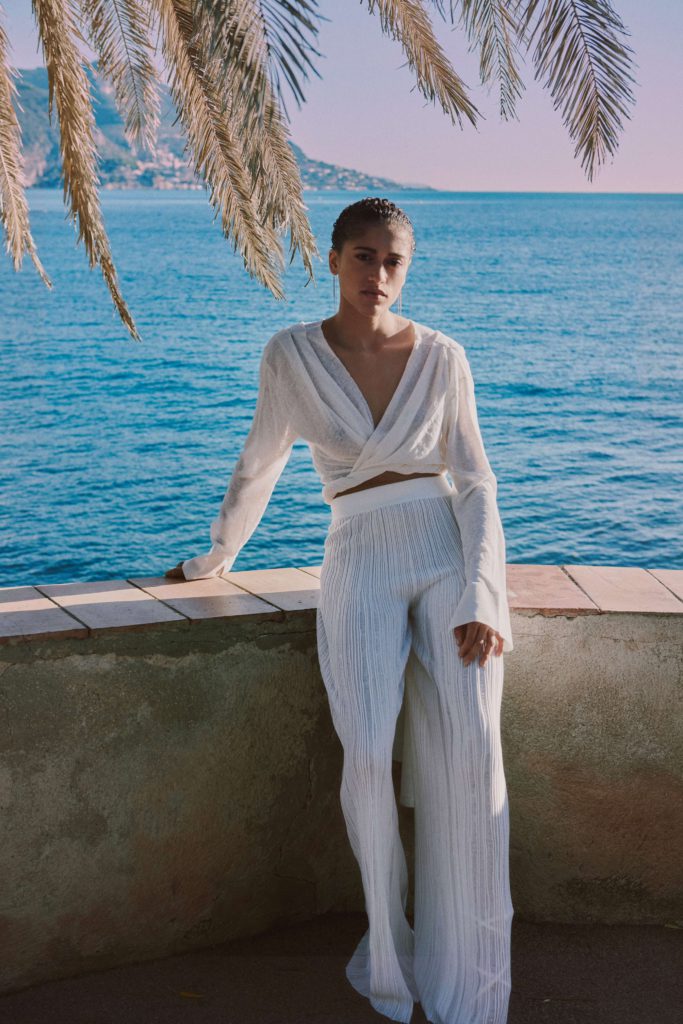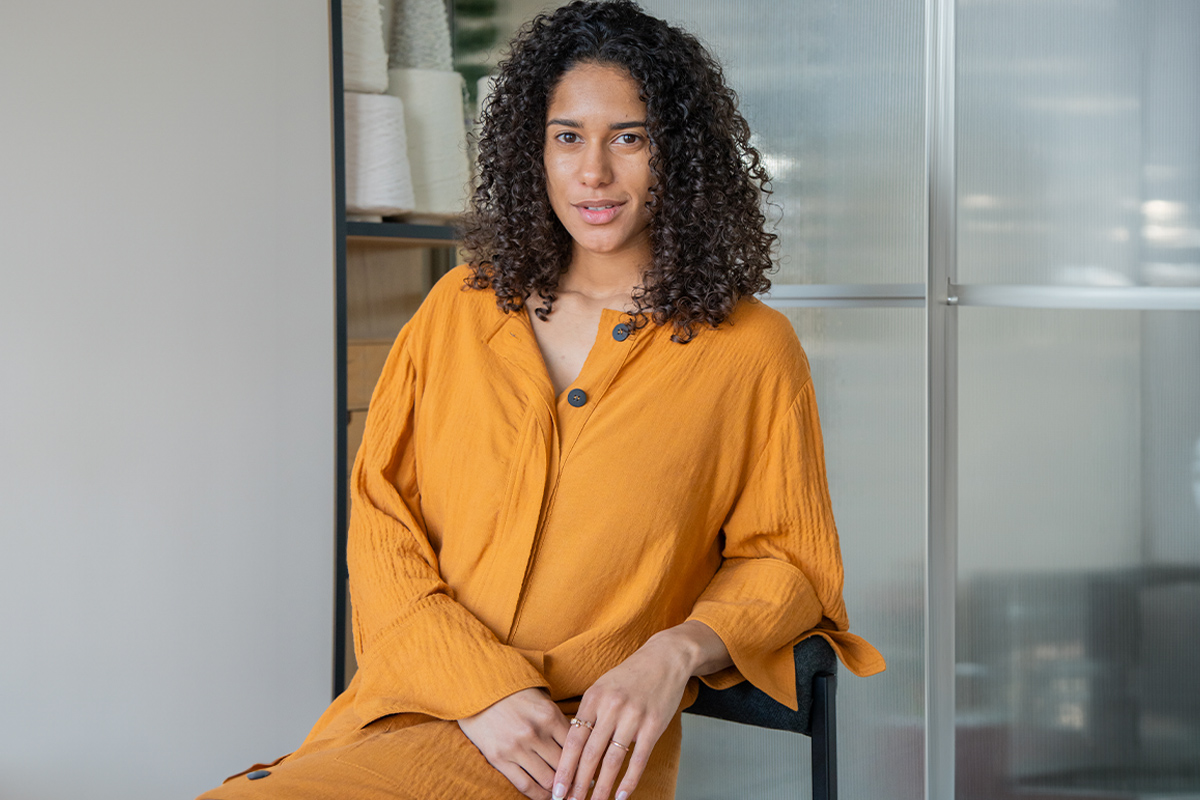Gaia Liesdek is the designer who brought the GALIU brand to life, which stems from her deep passion and appreciation for artisanal and technical knitwear. Every new project is developed from an experimental starting point and with a progressive vision to elevate knitwear, beginning with the careful selection of refined yarns.
We got to know Gaia Liesdek because, for her most recent creations, she chose two of the most interesting yarns from our catalog, namely Stephen and Roy, which perfectly represent the precious and delicate essence of Filidea, combined with high sustainability and performance value.
Galiu’s creations impressed us with their quality and the ability to enhance not only the qualities of those who wear them but also the characteristics of the materials from which they are made. For this reason, we wanted to chat with Gaia to capture her special perspective on fashion, design, and clothing, the values we share, and the sector’s prospects towards greater sustainability.
Enjoy the read.
Hi Gaia, can you tell us what Galiu is and what its values are?
Galiu is a knitwear brand focusing on bridal- and occasion wear, bringing a breath of fresh modern elegance. The overall style of the collection is minimalistic yet rich in texture, quality, and elegance. The vision for the brand is to create valuable and lasting products for people who will recognize and appreciate them.
The yarns you chose for your creations, Roy and Stephen, share the fundamental presence of Bemberg™ Cupro. When and how did you discover this type of product?
I got to know Filidea about two and a half years ago when I was working for Knitwear Lab as a knitwear developer and project manager. I was in charge of yarn research, so I know the product practically because I was actively looking for it: many of our clients were increasingly requesting sustainable options and Bemberg™ Cupro was an obvious choice in many cases.
And after that experience, you adopted the choice of Cupro in your creations with Galiu.
Exactly. With Galiu, the goal is to create heirloom pieces that are beautiful in their simplicity and easy to wear. Materials play a very important role here and set the tone for each style. Silk is synonymous with elegance, making it a very suitable material. Since sustainability is an essential part of Galiu’s brand identity, materials are carefully selected to have the least environmental impact possible while maintaining the aesthetics of the designs and the brand.
Stephen was the perfect choice, as it possesses the richness, sheen, and elegance of silk but is reinforced by its combination with Bemberg™ Cupro, without compromising aesthetics. Additionally, the fact that both Shappe silk and Cupro are made from waste or by-products made the choice clear over any other material.
For Roy, the elements are twofold: definitely the fact that it is so similar to silk while being very easy to handle, even when the product is finished. The garment has this silky feel and appearance but is easy to manage, making it perfect for the two garments I used it for: body-hugging dresses, one long and one short, which are very easy to wear. It’s all about simplicity, but sophisticated and elegant, and I think Roy fit very well into this concept.
How does sustainability influence your design and production decisions, and how do you ensure materials like silk and Bemberg™ Cupro adhere to these principles?
I commit to creating sustainably by first selecting materials that are preferably natural. Where possible, I always avoid mixing natural and synthetic materials. Secondly, I try to select materials that have the least impact on the environment while being of quality, durable, and aesthetically pleasing.
When I started Galiu, choosing flat knitting as the main technique for my products was a fundamental choice to produce more sustainably: creating fully shaped pieces, minimizing production waste. The choice of the right yarns is also part of this. Yarns that contain a significant percentage of fibers like Bemberg™ Cupro adhere to the vision, as its environmental impact is relatively low. Silk, in general, is known to be less animal-friendly, however, choosing the right source/supplier l and opting for Shappe silk helps staying within my sustainability goals.
In some cases, unfortunately, I can’t realize all my design ideas, as they don’t yet fit my vision of sustainability. For example, I would like to create some knitwear pieces with sequins, but since these are mostly made from synthetic raw materials, I decide not to use them for now. I hope that in the future there will be more sustainable options.

What process do you follow in selecting material suppliers like Filidea and how does collaborating with them contribute to the success of your garments?
I consciously choose the types of materials and research the production process of certain yarns: I am always attracted to suppliers who are innovative in their sustainable practices, both in raw materials and in the production process. Additionally, I greatly appreciate good cooperation with a supplier. For a small brand, it is often difficult to reach certain minimums, but it is fantastic when suppliers are willing to find a mutual solution or are proactive and willing to offer potential alternatives. Knowing Filidea, I am aware of the quality and innovation of the yarns in the catalog, and I have always found transparent and honest communication.
Do you think this meticulous and passionate research for yarns and materials that combine quality and performance with strong sustainability value is understood by the end consumer?
This is still a difficult part because I think it is still very little understood and this also makes my business more difficult.
As I said, however, this does not scare me: I made a clear choice and I also apply it in my consumer choices: I am very careful about what I buy and why I buy it.
And fundamentally, that’s how I make my products. I think many people who see my collection are not yet aware, but at the same time, I think it is also our responsibility to educate people. And I hope to do more even with my brand on my Instagram account and on my website, I plan to create an extra page to talk about materials because I see that people really need to be educated about this.
Most people may not immediately recognize the efforts you make to keep it sustainable, but I believe that a brand like Galiu must make very specific choices and this means that you cannot do certain things because they simply do not fit the values or your vision. These difficult choices are what set us apart and give value to what we do.
Bemberg™ Cupro certainly deserves to be explained and made understandable to the general public because it really represents a fiber with very interesting potential.
I think it’s an amazing material that not many people know about, although when you meet someone who knows it and realizes the dress is 100% Bemberg™ Cupro, they are pleasantly surprised. I would love to wear it in woven fabrics. I’ve been wearing it for a long time and I’m really a fan of it, but it is used little. I think even in stores, and this surprises me, also because of the price, which is obviously very advantageous: if you compare it to silk, there is a big difference, yet you get a similar feeling of luxury and quality, making it a perfect alternative. Customers who try it then ask us for more products made with Cupro yarns.
What future trends do you foresee exploring in the world of sustainable fashion and how do you plan to incorporate innovative materials into your future projects?
- More new low-impact cellulosic materials (minimal carbon emissions and minimal water consumption)
I expect raw materials like seaweed, banana leaves, sugarcane, etc., as artificial yarns to be more commercialized and suitable for knitting. - More regenerated cellulosic materials and post-consumer recycling
I hope and expect that in the future there will be more options for recycled cellulosic materials and, hopefully, the possibility to recycle 100% cellulosic fabrics will be available in the near future, creating circular fabrics, even for smaller brands. - Using what is available (creating with stock remnants)
This is already happening, but I foresee it growing for brands that will start using advanced materials from previous productions. This is something I would like to focus on as well, challenging myself to create beautiful pieces with what suppliers have left. In this case, the yarn would be the inspiration for the design.
With Galiu, I don’t want to stick to the usual way of doing things. The goal is to innovate and surprise the public with what is possible in the field of knitwear and bridal dresses. Using innovative and perhaps unexpected yarns will be part of this.




